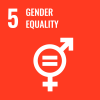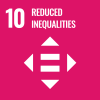
 Introduction
Introduction
Discrimination, or unjust differential treatment on the basis of, for example, sex, race or ethnicity, age, income or wealth, disability, caste, sexual orientation, religion, or migrant status, causes harm and drives exclusion in social, economic, political and cultural life. Where it occurs in the delivery of public services, it further undermines public trust and confidence in public institutions. In recent years, growing evidence of discrimination has brought the issue to the forefront of many societies and provoked both individual and collective reflection. Although the principles of equality and non-discrimination are widely entrenched, discrimination affects public administration as it does society in general. There is no comparable data across countries that fully sheds light on the level and extent of discrimination by public administration. This may be due to factors such as the difficulties of measuring discrimination, under-reporting of incidents of discrimination and the limited public availability of such reporting, and how broadly non-discrimination is approached (for instance, which groups are protected and to what extent). A limited amount of information is available for some countries and country groupings (mainly developed countries), and some social groups. 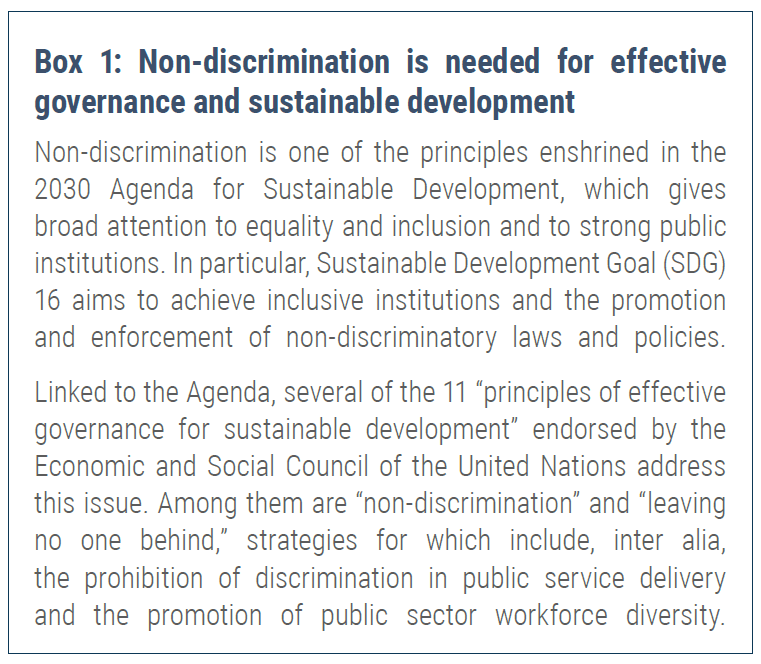 Despite the lack of global comparable data, a range of evidence shows that discrimination–both in law and policy and interpersonal– occurs on the part of public administration and in countries at different levels of development. In fact, public administration in its various roles from the national to the local levels can both be a vehicle for discrimination and provide channels to address it. This brief considers a selection of entry points that public administration can pursue, in addition to others, as part of a comprehensive and consistent approach to promoting non-discrimination. The broad promotion of non-discrimination not only benefits society and institutions by making them fairer and just, but can also serve other goals by, for example, facilitating the engagement of citizens across social groups with government, promoting social mobility through improved quality of public services and employability of groups disadvantaged by discrimination, and encouraging or reinforcing non-discrimination in the private sector. Across all countries, but especially in conflict prevention and post-conflict contexts, diversity in public administration can help serve to avoid undue influence in State institutions by elites.
Despite the lack of global comparable data, a range of evidence shows that discrimination–both in law and policy and interpersonal– occurs on the part of public administration and in countries at different levels of development. In fact, public administration in its various roles from the national to the local levels can both be a vehicle for discrimination and provide channels to address it. This brief considers a selection of entry points that public administration can pursue, in addition to others, as part of a comprehensive and consistent approach to promoting non-discrimination. The broad promotion of non-discrimination not only benefits society and institutions by making them fairer and just, but can also serve other goals by, for example, facilitating the engagement of citizens across social groups with government, promoting social mobility through improved quality of public services and employability of groups disadvantaged by discrimination, and encouraging or reinforcing non-discrimination in the private sector. Across all countries, but especially in conflict prevention and post-conflict contexts, diversity in public administration can help serve to avoid undue influence in State institutions by elites.
Select entry points utilized to address discrimination by public administration
The following entry points to tackle discrimination cut across several levels of public administration: the macro level, the level of individual public organizations, and that of public servants themselves. They also cover service delivery, through which public administration interacts with the public, as well as mechanisms of accountability to the public.
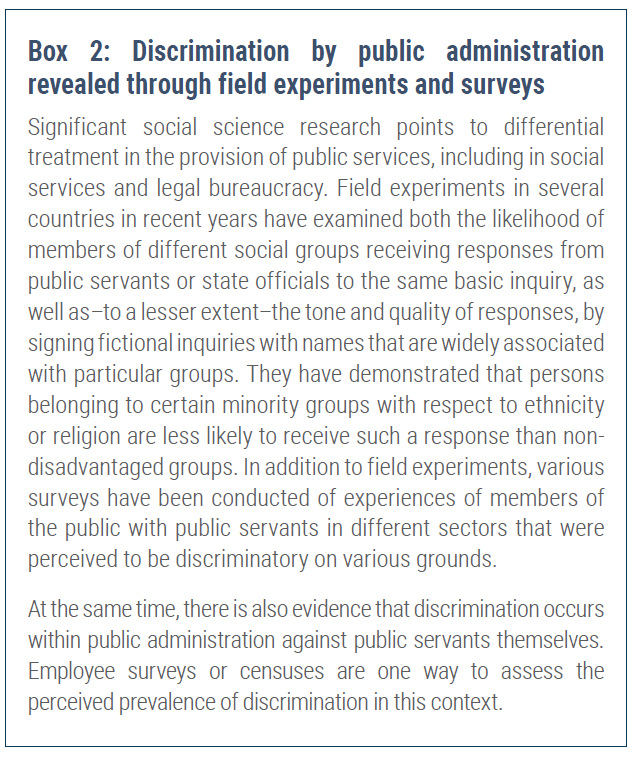 Citizens’ charters
Citizens’ charters
Over the past few decades, many countries have adopted citizens’ charters as a means to improve the quality of public services and their responsiveness to citizens’ needs, and to promote good governance principles such as transparency and accountability. Though they differ in content and may be in place at different levels of government or in different sectors, citizens’ charters comprise government commitments to citizens to meeting standards in public services. Such charters have been adopted, for instance, in India, Jamaica, the United States of America (USA), and across the European Union (EU). Within the EU, the majority of citizens’ charters provide a general commitment to non-discrimination or equal treatment, with some specifically referencing non-discrimination on the grounds of disability; race, ethnicity or religious identity; gender, sexuality or marital status; or age; and committing to accessibility of service for persons with disabilities or in multiple languages. Belgium has a specific charter on non-discrimination, while a ministry in Greece has a charter specifically for persons with disabilities. Some charters are rooted in law while others are more informal, and it is a challenge for many countries to measure compliance.
Positive duties
There has been increasing movement in recent decades towards the introduction of positive duties that require by law governments and, in some cases, also other actors to tackle discrimination. A positive duty imposes an obligation to take action, thereby taking a proactive–rather than reactive–approach to ending discrimination, one that encompasses prevention. It recognizes that discrimination is a systemic problem rather than one characterized by individual incidents that must be reported in order to be addressed, and broadens responsibility for inequality. This approach is called for in several international legal instruments, such as the Convention on the Rights of Persons with Disabilities. The United Kingdom of Great Britain and Northern Ireland’s (UK) Public Sector Equality Duty, an element of the Equality Act 2010, is a notable example of a positive duty. It is comprised of both a core general equality duty as well as specific duties. The general duty requires all public authorities and other organizations, such as private bodies, that exercise public functions to “have due regard to the need to” end discrimination, harassment and victimization on an expanded range of protected characteristics, as well as to advance equality of opportunity and foster good relations between those who share a protected characteristic and those who do not in fulfilling their functions. The specific duties are regulations aimed at supporting performance on the general duty through improved focus and transparency. Several other countries and regions have established positive duties. Ireland’s Human Rights and Equality Act of 2014 requires public bodies to lay out in their strategic plans an assessment of the rights and equality issues they deem relevant to their functions and purposes as well as policies and plans to address them, and to report on progress and achievements in their annual reports. In the state of Victoria, Australia, the Equal Opportunity Act 2010 lays out a positive duty on the part of all organizations covered by law, including government, the private sector, and the community sector. Some positive duties apply to certain sectors only, such as employment, or with regard to individual protected grounds. For instance, in Kenya, the Employment Act 2007 obligates the Minister, labour officers and employers to promote equality of opportunity in employment, and the Persons with Disabilities Act 2003 requires the government to take steps using all available resources towards fully realizing the rights of persons with disabilities. Where positive duties are in place or introduced, public administration can explore different ways to enhance their effective implementation. Yet even where such duties are not enshrined in legislation, public bodies can consider adopting a similar approach in policies in order to mainstream consideration of non-discrimination and equality in the course of daily work.
Public procurement
Public procurement is another channel through which non-discrimination can be promoted and public administration at all levels can set an example. Given its significant volume– accounting for an average of 13 per cent to 20 per cent of GDP–public procurement can serve as an important instrument to advance social goals. Most procurement laws are rooted in the two principles of best value for money and acting fairly, the latter of which aims to achieve a level playing field for market participants, including through addressing barriers and constraints. Social considerations in the public procurement process may relate to recognizing equality and diversity, ensuring adherence to labour laws and standards, promoting innovation and business development, or supporting the expansion of employment and skills. Governments are increasingly attentive to social criteria in public procurement, among which diversity and equality have grown in importance. Many countries set preferences or targets for spending or procurement opportunities. For instance, South Africa’s Constitution stipulates that procurement policy should provide for preferences in allocating contracts and protect or advance persons or categories of persons who are disadvantaged by discrimination. Accordingly, the country’s Preferential Procurement Policy Framework Act, 2000 (amended in 2011 and 2017), which has been harmonized with its Broad-Based Black Economic Empowerment (BBBEE) Act, 2003 (amended in 2013), provides a system for evaluating bids from enterprises according to criteria that include categories of preferences on several grounds, among them race, gender, disability and age. Australia’s 2015 Indigenous Procurement Policy contains yearly, increasing targets for the number of contracts to be awarded to indigenous businesses, a mandatory set-aside rule for contracts in remote areas and within a certain range of value, and requirements for indigenous participation in employment or supplier use in high-value contracts in some sectors to promote indigenous business development. In Kenya, the law requires that 30 per cent of government procurement opportunities be set aside specifically for enterprises owned by women, youth and persons with disabilities. Another approach to public procurement that is disability-inclusive is reflected in the EU’s Public Procurement Directive of 2014, which requires member states to use procurement to enhance accessibility.
Institutional culture
Institutional culture is a determinant of the degree to which a public body is non-discriminatory, diverse and inclusive, and of the success of initiatives that promote those aims. Many such cultures disadvantage women and other groups implicitly or even explicitly through prevailing stereotypes and practices that, for example, favour advancement by ethnic majority males or discourage engagement with minority communities. While many factors influence institutional culture, leadership and training are important among them. Strong high-level leadership can set an inclusive tone and priorities within an organization that help to deter discriminatory practices and attitudes as well as generate and retain a diverse staff. Staff training on implicit/unconscious bias or diversity awareness or sensitivity is another important means of changing institutional culture. It may address, for instance, understanding the value of diversity and inclusion, enhancing cultural awareness, improving communication, and questioning one’s assumptions and behaviours. Training on the prevention of harassment and bullying is also relevant, as these harmful behaviors can particularly affect marginalized groups. Many experts recommend that trainings build both awareness of unconscious biases as well as the capacity to address the impacts of those biases through specific strategies and support, and that training activities be sustained rather than one-off. Training related to diversity, inclusion and equality is relatively common in both the public and private sectors. Across organizations, it may be mandatory or voluntary, and for all or some levels of staff and those serving on selection committees. With regard to targeted training, Japan recently mandated the completion of training on the prevention of sexual harassment by central government officials, while Timor-Leste’s Civil Service Commission, together with UN Women and Juridico Social Consultoria, a company specializing in social justice projects, has been training civil servants across the country’s municipalities on the use of binding guidelines, launched in 2017, addressing sexual harassment in the civil service.
Artificial intelligence (AI)
Given both the promise of and risks posed by AI, governments are increasingly looking at ways to help ensure that it is utilized responsibly and fairly by all. Within public administration, AI is increasingly used in various areas of public service delivery– from determining eligibility for social benefits to predicting crime–where bias and discrimination have the potential to cause serious harm to many. Measures can be taken to reduce those challenges in AI. At the same time, AI tools can be used specifically to address them. Use of AI systems is subject to anti-discrimination law; even where bias affects AI unintentionally, as is often the case, many laws are applicable to direct and indirect discrimination. Notably, the EU adopted the General Data Protection Regulation regarding the processing and free movement of personal data (2016/679), and guidelines are available on “automated individual decision-making and profiling for the purposes of Regulation 2016/679,” both of which address discrimination. The law applies to public and private organizations. Countries are also soliciting expert recommendations and considering and implementing strategies and measures to address and prevent discrimination in AI, often within the broader context of its ethical use. For instance, the government of Mexico adopted a strategy on AI in 2018, which led to the creation of a dedicated Directorate and the publication of general principles, including fostering of equality by reducing risks of discrimination, for the development and use of AI systems within the national government. Some recommendations put forth by experts across countries to promote non-discrimination in this area include undertaking disparate impact studies in areas where public administration has jurisdiction; promoting diversity and transparency in AI development; developing audit tools and processes for algorithms, and a national body charged with such audits; and discontinuing use of “black box” AI and algorithmic systems (those whose internal mechanisms are unknown to the user) because of due process concerns, or at least making them available for public auditing, testing, and review, and accountable to standards. Despite the serious risks, the potential for AI to improve public service is significant, and AI and big data systems have been utilized with the specific purpose of tackling discrimination and inequality. For instance, AI has been used in the development of a tool to temporarily remove certain demographic details from police reports with the aim of eliminating the potential for bias to influence decisions regarding charging individuals with a crime. It has also been used to gather and analyze data on hate crimes provided by local law enforcement agencies.
Promotion of workforce diversity
Within public administration, non-discrimination is often pursued through initiatives of diversity and inclusion, both as objectives in and of themselves and because they can advance the performance of government organizations. The promotion of diversity and inclusion entails building a representative environment that values and supports the potential of all workers and ensures that some do not have unfair advantage over others. A diverse organization taps all segments of the population, for instance including women, youth and older persons, persons with disabilities, LGBTI persons and indigenous persons and members of ethnic minority groups, for a range of talents, knowledge, experiences and perspectives which are leveraged for creative problem-solving and to understand the needs of–and best serve–its diverse clients. Workforce diversity is associated with innovation that may help to improve public service efficiency and improved quality of outputs. Increased representation of historically-disadvantaged groups in bureaucracies has also been found in some cases to improve effectiveness in realizing goals that support those groups’ interests. Yet diversity can also lead to challenges, including group conflict, poor communication, dissatisfaction, turnover and poor performance. In order to maximize its potential, it must be carefully managed towards creating an enabling environment for inclusion. Diversity efforts in public administration are ideally rooted in a government-wide strategic framework. A legal framework is also key to ensure that organizations and public servants are bound to pursue diversity and safeguard the protection of individual privacy. Some policies contain goals or targets. Many countries have mandated a representative public administration or quotas for specific disadvantaged groups. For instance, Mexico has a quota for women in senior civil positions and has seen a notable increase in the number of women in such posts. For persons with disabilities, it is estimated that at least 90 countries have quota requirements in the public sector.
Schools of public administration
The promotion of non-discrimination in public administration depends in large part on having competent employees who have a good understanding of and strong commitment to equality and related goals. This is likely to be influenced by employees’ preparation for public service in schools of public administration. Scholars increasingly recognize the value of teaching diversity and cultural competence in public affairs education in order to equip public servants to be responsive to evolving societies with various experiences, needs and values, and to promote social equity. While these issues are addressed in many such schools, they are not addressed universally or robustly in all cases and may continue to be seen as peripheral or specialized. However, more research is needed in this area across regions. 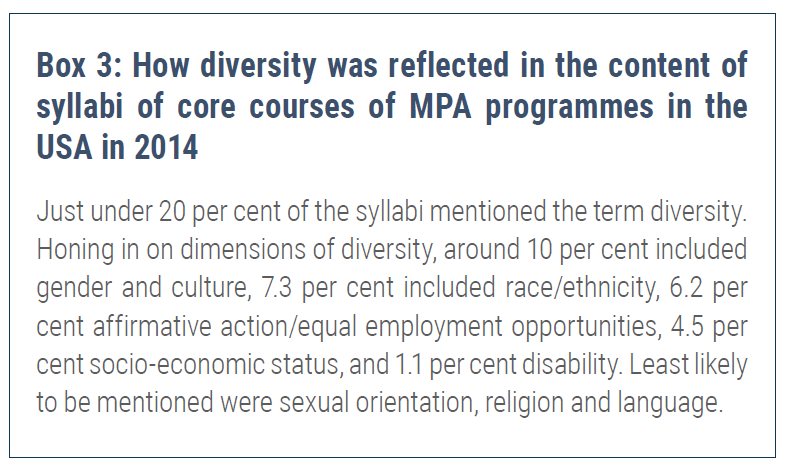 In the USA, the National Association of Schools of Public Affairs and Administration (NASPAA) required diversity to be addressed in curricula and courses by programmes seeking accreditation in 2007. In 2009, it further required programmes to assess students’ competencies to engage with a diverse workforce and diverse citizens. However, a 2014 study analyzed the content of the syllabi of core courses of 50 schools’ Masters of Public Administration (MPA) programmes and found that dimensions of diversity were poorly reflected. Similarly, a survey of 11 public administration education and training programmes across nine countries of Central and Eastern Europe regarding their responses to multi-ethnic communities and diversity revealed that none reported having any courses that addressed serving in public administration in diverse communities, though three reported having relevant activities related to research or projects. The author of that survey points to the potential for schools to support needed research on diversity and equity as well as programmes to identify and recognize excellence in public administration practice in managing diversity. Both studies stress the importance of diversity in the composition of schools and of mainstreaming diversity issues.
In the USA, the National Association of Schools of Public Affairs and Administration (NASPAA) required diversity to be addressed in curricula and courses by programmes seeking accreditation in 2007. In 2009, it further required programmes to assess students’ competencies to engage with a diverse workforce and diverse citizens. However, a 2014 study analyzed the content of the syllabi of core courses of 50 schools’ Masters of Public Administration (MPA) programmes and found that dimensions of diversity were poorly reflected. Similarly, a survey of 11 public administration education and training programmes across nine countries of Central and Eastern Europe regarding their responses to multi-ethnic communities and diversity revealed that none reported having any courses that addressed serving in public administration in diverse communities, though three reported having relevant activities related to research or projects. The author of that survey points to the potential for schools to support needed research on diversity and equity as well as programmes to identify and recognize excellence in public administration practice in managing diversity. Both studies stress the importance of diversity in the composition of schools and of mainstreaming diversity issues.
Public audits
Public administration can also look to assessments, conclusions and recommendations of relevance to the promotion of non-discrimination that are provided by oversight bodies at national and local levels through audits. Audits can provide valuable insight about bottlenecks and good practices in policy implementation and organizational practice and are a critical accountability mechanism. Public audits can take different forms and be conducted from within government or by independent oversight bodies. Inclusion is an increasingly prominent issue within supreme audit institutions (SAIs), which can undertake a range of pertinent audits, from compliance with international standards and national laws on non-discrimination to the performance of a government’s equality initiative or policy. For example, the Office of the Auditor General of Argentina conducted a comprehensive audit of that country’s rail system in 2003-2004 that not only covered transport accessibility but also incorporated the participation of organizations of persons with disabilities in defining its objectives and in carrying out field work. The Netherlands Court of Audit recently undertook an audit of several algorithms used by the government, including with regard to bias. Audits related to non-discrimination, equality and inclusion are increasing in frequency in connection with auditing the Sustainable Development Goals. Particular attention is being given to including gender as both a subject and criterion of audits. As of 2017, 17 per cent of SAIs had conducted a dedicated audit on gender, and 19 per cent had included gender assessments in their audit work. Recently, 16 SAIs and one subnational audit office from across Latin America and the SAI of Spain undertook an audit of SDG preparedness that focused on SDG 5 on gender equality and women’s empowerment. One example of a public audit initiated from within government is that launched in 2016 by the UK’s Prime Minister to explore racial disparities in public services. The Race Disparity Audit is a programme to identify and gather data on outcomes by race and ethnicity across public services and government departments in order to promote positive change through transparency of data. The programme created a public website entitled “Ethnicity Facts and Figures” that spans multiple sectors, including health, housing, criminal justice, employment, education and culture. It has led to both policy and legislative measures, such as targeted employment support in areas with particularly high levels of ethnic minority unemployment.
Conclusions and recommendations
Discrimination by public administration remains a challenge. Research on its level and extent is needed across countries, in particular developing countries, to better inform the development of appropriate responses. In general, there is a need to be more deliberate in considering how discrimination can occur–notably through the use of new technologies. At the same, there are clearly possibilities for innovative approaches to detect and reduce discrimination through those same technologies. On these fronts, strengthening technical capacity in public administration should also be prioritized. The promotion of non-discrimination needs to be formally mainstreamed throughout public administration. Various entry points are available that can be fully utilized to tackle discrimination. In examining a selection of them, this brief points to the value of a comprehensive approach. Non-discrimination is cross-cutting and cannot be achieved through a singular measure or instrument. Strategies that uphold non-discrimination as a public service standard, support inclusion through public procurement, instill a proactive and binding approach to non-discrimination, foster an institutional culture of inclusion, consider and reduce the risk of bias in AI, promote diversity, and better prepare future public servants to respond to discrimination and related challenges can support non-discrimination from various angles that are mutually reinforcing. Strategies to promote non-discrimination in public administration should reflect the input of stakeholders, including civil society and community organizations, in particular those representing groups that are discriminated against, obtained through formal engagement mechanisms. They should be subject and responsive to monitoring and an effective accountability system, processes that should also be inclusive of stakeholders. Other entry points to prevent and tackle discrimination by public administration that are not covered here should also be considered and examined. For instance, effective mechanisms for reporting discrimination by public servants and for monitoring public service delivery to try to ensure that it upholds the principle of non-discrimination and addresses cases of discrimination that do occur appropriately are additional key entry points to pursue.
 Welcome to the United Nations
Welcome to the United Nations
